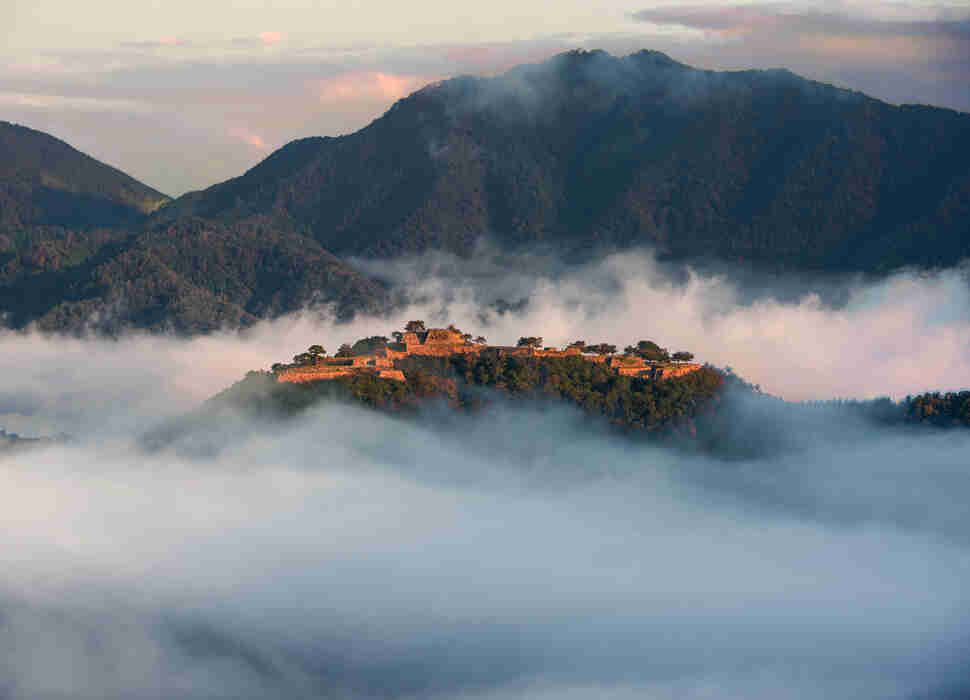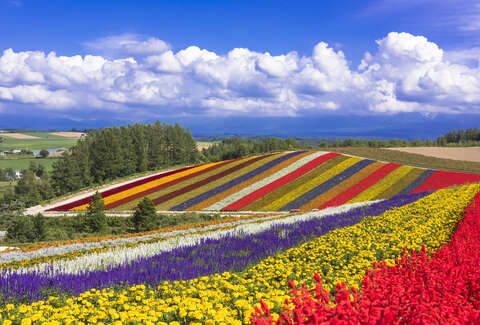CRAZY-GORGEOUS THINGS TO SEE IN JAPAN THAT AREN'T CHERRY BLOSSOMS
Japan is a bit of a conundrum. It's old, dating back thousands of years with a history and culture steeped in intricate tradition. And yet it's also modern -- at times overwhelmingly so -- home to both the art of karaoke and Pikachu. On this island about half the size of Texas you'll find dense technicolor cities with buildings reaching up for the heavens, plus lush, untouched landscapes that might actually be entryways to the afterlife. Japan can be whatever you want it to be. But no matter which side of the coin you land on, it's bound to be breathtaking. To prove our point, we've rounded up some of the most awe-inspiring sights to see on the island nation to convince you to get there now.

Kawachi Fujien wisteria garden, Kitakyushu
People make a big to-do about Japan's cherry blossom season. It's spectacular, but it's not the only reason to visit in the spring. In late April to early May, head to the southern city of Kitakyushu to see over 22 types of wispy wisteria at the garden of Kawachi Fujien. This popular spot is only open during wisteria season and when colors start to change in the fall. There are two stunning tunnels draped with long swaying wisteria vines to mosey through.

Takeda Castle, Asago, Hyogo Prefecture
Often referred to as Japan's Machu Picchu, Takeda takes castle on a cloud to a whole new level. It's believed to have been built in 1443 but was ultimately left abandoned by the 17th century. To catch the morning mist shrouding the castle, and the magical views that follow, bring a Thermos of coffee and set up camp before sunrise.

Meoto Iwa, Mie Prefecture
This set of scared rocks in the middle of the ocean represent a husband and wife (Meoto Iwa signifies "the Wedded Rocks"). The rope connecting them, called a shimenawa, is ceremoniously changed three times a year. On a lucky day it's possible to catch the sun rising between the rocks and the subtle silhouette of Mount Fuji in the distance.

Sagano Bamboo Forest, Arashiyama, Kyoto Prefecture
For the Japanese, bamboo is a symbol of strength, and it's often found near temples to ward off evil. So it only makes sense that Kyoto, the "City of Ten Thousand Shrines," is home to a spectacular bamboo grove. Paths and bike trails weave throughout this dense, otherworldly forest, but even the rustling of tourists can't disturb the chillingly calm sound of the bamboo swaying in the wind.

Senso-ji Temple, Tokyo
Founded in 645 -- or, 1,000 years before the United States -- Senso-ji is Tokyo's oldest temple, and one of those rare tourist attractions worth fighting the crowds to see. After passing through Kaminarimon, the entry gate with a massive lantern and throngs of selfie takers, the grounds turn into an eclectic shopping area with hundreds of stalls selling traditional Japanese souvenirs and snacks like chopsticks and mochi.

Motonosumi Inari, Yamaguchi Prefecture
In Japan's native religion, Shinto, it is believed that the divine spirit dwells in all of nature. Motonosumi Inari might be one of the best places to experience this interconnectedness. Visitors ascend through 123 bright-red torii gates, which are typically found at the entrance of a shrine and symbolically mark the transition into a sacred space. At the end of the tunnel, guests attempt to toss coins into an offering box that sits 16ft up on top of a torii gate. Just don't forget to make a wish, because if your coin lands, it's guaranteed to come true.

Lake Kawaguchiko, Yamanashi Prefecture
Lake Kawaguchiko is easily accessible from Tokyo and a prime spot for mind-blowing views of Fuji-san. Early-morning mist gives the mountain an ethereal vibe in this sacred, inspiring landscape.

Kabira Bay, Ishigaki Island, Okinawa Prefecture
Japan isn't all skyscrapers and mountains. Far off the mainland, the island of Okinawa offers sandy beaches with crystal-clear waters, coral reef, and some of the happiest people around. Unfortunately Kabira Bay doesn't allow swimming or snorkeling, but you can hop on a glass-bottom boat to see everything the waters have to offer.

Osaka's Shinsekai, or "New World" district, was designed in 1912 to feel like a mix between Paris and New York. While the Tsutenkaku Tower may be an, er, ode to the Eiffel Tower, today this bustling area is fully Japanese with its bright alleyways full of glowing neon signs, flashy advertisements, and floating paper lanterns.

Osaka Castle, Osaka
Sitting smack dab in the middle of the city, Osaka Castle acts as an anchor that holds down the history and tradition of ancient Japan in a surrounding sea of skyscrapers. The castle's had a tumultuous history -- it burnt down in the 17th century and was attacked by Godzilla in the 1955 Godzilla Raids Again -- but has been repeatedly restored to its former glory.

Biei Blue Pond, Shirogane, Hokkaido Prefecture
Way up north in rugged Hokkaido swirls the Biei Blue Pond, aptly named for its enchantingly blue waters whose hue changes with the seasons (or even just a change in the wind). The pond is full of lifeless larch and silver birch trees that reflect on the surface like a turquoise mirror.

Situated on Miyajima, which literally translates to "shrine island," Itsukushima is famous for being built over the water. Catch it at high tide and the whole complex appears to be floating. Two hundred meters offshore, the Great Torii has been warding off evil spirits since 1168.

Arriving at Shikisai-no-oka, you might think your train was diverted and you somehow ended up in the Netherlands. It's not Europe, but the colorful patchwork of dozens of varieties of flowers in the quaint hillside village of Biei-cho would leave any monarch jealous. The park is open year-round, but you'll catch the fields at their best from April to October.

The 1,200 deer who live in Nara Park are not only considered a national treasure, but also messengers of the Shinto gods. The deer are extremely friendly and always ready for snacks that can conveniently be purchased within the grounds.

Fushimi Inari, Kyoto
Japan's most popular tourist attraction is this Shinto shrine dedicated to Inari, the god of rice. Thousands of torii gates form a maze of vermillion-colored tunnels. Each torii gate was donated by corporations or individuals as a way to give thanks for their prosperity.

Shibuya Crossing, Tokyo
When the crosswalk signals turn green, up to 2,500 people walk across the stripped pedestrian lanes of Tokyo's Shibuya Crossing. It's the type of place that feels like a dream: the rush of the people, thousands of neon lights advertising department stores and television shows, and the vibrant, nonstop energy that is Tokyo.

Jigokudani Wild Monkey Park, Nagano
Like anyone having a spa day, the monkeys of Jigokudani just don't really give a damn. The creatures can be found relaxing in the hot springs year-round, but are particularly fond of the water during the snowy winter months. Don't expect to bathe with the little guys, though. This hot spring is "monkeys-only."












No comments